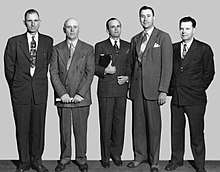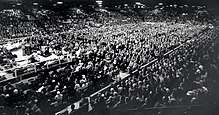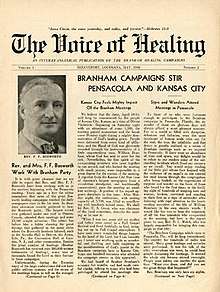Healing revival
Healing revival is a term used by many American Charismatics in reference to a Christian revival movement that began in June 1946 and continued through the 1950s. The period of revival was a significant influence on the modern charismatic movement.

Evangelists
The period of revivals was described by Christian writer John Crowder as "the most extensive public display of miraculous power in modern history."[1] Some, like critic and radio personality Hank Hanegraaff, rejected the entire healing revival as a hoax, and condemned the subsequent evangelical and charismatic movements as a cult.[2] Divine healing is a tradition and belief that became increasingly associated with Evangelical Protestantism.[3] The majority of American Christianity's fascination with divine healing played a significant role in the popularity and inter-denominational nature of the revival movement.[4]
Oral Roberts and William Branham are described by historian David Edwin Harrell as the two giants of the movement. William Branham, who died in a 1965 car accident, is widely regarded as the initiator and the pacesetter of the revival, and described by Harrell as the movement's "unlikely leader."[5][6] Roberts emerged as the most popular figure and left the most lasting legacy, including the university bearing his name. Referring to Branham’s first series of meetings in St Louis’ in June 1946, Krapohl & Lippy have commented: "Historians generally mark this turn in Branham’s ministry as inaugurating the modern healing revival".[7]
Branham was the source of inspiration for T. L. Osborn's worldwide crusade ministry and dozens of other smaller ministries involved in the healing revival.[8] Other major figures of the revival were Jack Coe and later A. A. Allen. Many of these ministries shared their healing testimonies in The Voice of Healing, a periodical published by Gordon Lindsay, which created cohesion for the group in its nascent years.

1956 peak
In 1956, the healing revival reached its peak number of evangelists holding campaigns, as 49 separate evangelists held major meetings.[9] By 1960 the number of evangelists holding national campaigns dropped to less than a dozen.[9] Several perspectives have been offered regarding the decline of the healing revival. Crowder suggests that Branham's gradual separation from Gordon Lindsay played a major part in the decline.[10] Harrell attributed the decline to the increasing number of evangelists crowding the field and straining the financial resources of the Pentecostal denominations.[11] Weaver similarly agreed that Pentecostal churches gradually withdrew their support of the healing revivals primarily over the financial stresses put on local churches by the healing campaigns.[12] The Assemblies of God led the way, being the first to openly withdraw from the healing revival in 1953.[12] Weaver pointed to other factors which may have played a role in destroying the initial ecumenism of the revival: tension between the independent evangelists and the Pentecostal churches caused by the evangelists' fund-raising methods; denominational pride; sensationalism; and doctrinal conflicts, particularly between the Oneness and Trinitarian factions within Pentecostalism.[12]

Results
A result of these major healing ministries of the post-War era was a renewed belief and emphasis in divine healing among many Christians, and this was a part of the broader Charismatic Movement, a movement which today numbers about 500 million worldwide.[13]
Footnotes
- Crowder 2006, p. 321.
- Hanegraaff, p. 173.
- Harrell 1978, pp. 11-12.
- Harrell 1978, pp. 4-6, 11.
- Harrell, D. E., All Things Are Possible: The Healing and Charismatic Revivals in Modern America, Indiana University Press, 1978 p. 25.
- Weaver, C. D., The Healer-Prophet: William Marrion Branham (A Study of the Prophetic in American Pentecostalism), Mercer University Press, 2000, p. 139.
- Krapohl, R. H., & Lippy, C. H., The Evangelicals: A Historical, Thematic, and Biographical Guide, Greenwood Press, 1999, p. 69.
- Dictionary of Pentecostal and Charismatic Movements (Grand Rapids, MI: Zondervan, 1988) p. 372.
- Weaver 2000, p. 91.
- Crowder 2006, pp. 330.
- Harrell 1978, p. 40.
- Weaver 2000, p. 92.
- Hollenweger, W. J., Pentecostalism: Origins and Developments Worldwide (Peabody: Hendrickson, 1997) p. 1.
Sources
- Crowder, J. (2006). Miracle Workers, Reformers, and The New Mystics. Destiny Image. ISBN 978-0-7684-2350-1.CS1 maint: ref=harv (link)
- Harrell, David (1978). All Things Are Possible: The Healing and Charismatic Revivals in Modern America. Indiana University Press. ISBN 0-525-24136-1.CS1 maint: ref=harv (link)
- Weaver, C. Douglas (2000). The Healer-Prophet: William Marrion Branham (A study of the Prophetic in American Pentecostalism). Mercer University Press. ISBN 978-0-865-54710-0.CS1 maint: ref=harv (link)